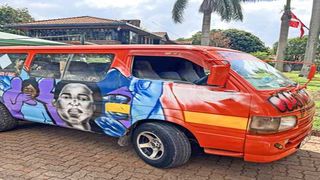
A matatu branded by graffiti artist Ndereva Mutua.
| Sila Kiplagat I Nation Media GroupKenya@60
Premium
60 years of matatu culture: A special look at Kenya's public transport
What you need to know:
- The matatus, independent of systemic limitations and governance policy, were highly flexible.
- The driver would go where the passengers wanted to go, not where a board of directors seated in London decided he would go.
- Since most of these vehicles carried the same people at the same times over the same routes every day, relationships between passengers and drivers were established and cemented.
'Shock as matatu drivers fail NTSA refresher licence renewal test' was the headline of an article on the Nation.Africa website two weeks ago.
As it turned out, Kenya's National Transport and Safety Authority put a number of matatu drivers through the wringer, and the result was worse than pathetic: a paltry 18 percent of them, 54 people out of the unfortunate 302 who started the exercise, passed.
One Mr Tuigong blamed a non-standard driving curriculum and the apparent ease with which licences had been obtained in the past. Mr Tuigong is not wrong, but he is not entirely right either.
And why was anyone surprised by the results? Were we expecting something else?
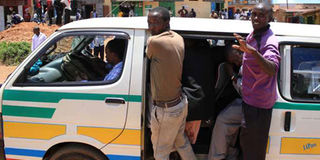
Matatu operators at work in Kisii.
Well, this writer has been known to attack with both barrels in the past, but hold on a minute. PSV operators: before you start throwing used oil filters at my windscreen and angrily navigating away from this site, allow me to clarify.
This is not an attack; if anything, it's almost a defence of your situation, but don't take it as an endorsement. Enrol in driving school and brush up on your road sign recognition skills by the time you finish reading this.
To understand how we got here with our underperforming PSV pilots, we need to look at the past, which is eerily similar to the present. We need to unpack the origins of these creatures of the genus Matwanas saccomembus and their evolution over the years to their current spread and diversity, ranging from such enviable bastions of competent professionalism and service delivery - let's call this subspecies Matwanas supermetro - to the sadder end of the scale, inhabited by creatures who could easily be the unwilling subjects of a particularly heartbreaking BBC documentary: the taxonomic class Matwanas indimanje - and everything in between.
Because, you see, this country is exactly 60 years old, and the circumstances that led to this hilarious farce of a written and applied theory NTSA assessment began exactly 60 years ago.We really should have seen this coming...
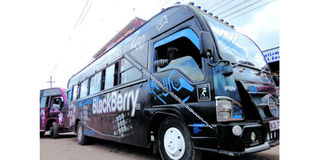
Blackberry, the beast of Rongai, one of the most popular matatus plying the Rongai-Nairobi CBD route.
Welcome to another instalment of Kenya@60, in which I will be using drastic verbal tactics to shackle the masses for several weeks as we look at personalities, companies, specific vehicles, notable events and discuss anything and everything that has shaped this country's motoring industry over the past six decades.
The origin of the species: In the beginning...
...there was patchwork.
In 1963, Nairobi, which was to become the hotbed and de facto headquarters of Kenya's matatu culture, was still in the grip of colonial hangovers. Those old enough to remember the pre-independence era will also recall the dreaded kipande system, under which indigenous Africans needed a pass to move around and a permit to enter Nairobi.
The city's transport system had been designed to cater for what was, in retrospect, a sparse European population, and public transport within the city was limited to a monopoly granted by the Nairobi City Council: Kenya Bus Service (KBS), established in 1934 and owned and operated by the London-based Overseas Transport Company (OTC).
Locals living on the outskirts of the city had to walk in and out of the city for work and trade, sometimes up to twenty or thirty kilometres. Segregationist policies also prohibited them from using the Kenya Bus Service to travel within the town (not yet a city), if they could even afford the fare.
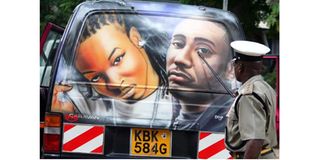
Police officers impound matatus with graffiti and DVD music systems in Mombasa on 6 January 2010.
Enter the entrepreneur.
There was clearly a gap to be filled, and it was filled quickly. Enterprising souls looked at the hundreds of weary walkers and decided to motorise them for a fee.
Some enterprising souls looked at the hundreds of weary pedestrians and decided to motorise them for a fee. These enterprising souls formed a patchwork alliance: former chauffeurs as drivers, white-trained mechanics and their apprentices as manufacturers and certain members of the public as financiers.
This patchwork alliance then proceeded to assemble patchwork vehicles - in pre-independence Kenya, motor vehicle ownership was the preserve of the few; you had to be wealthy and influential to buy or own a vehicle.
Entrepreneurs would collect dilapidated or discarded vehicles and spare parts and cobble together contraptions that could carry several people. These ramshackle jalopies were then strategically and illegally deployed on the streets of Nairobi to help locals get around. Think of this as the primordial point; the Zinjanthropus moment for today's Matwanas saccomembus.

Matatus parked at the Ngara Stage in Nairobi.
However, this is not the origin of the matatu as we know it, it was just the preamble. The matatu culture as we know it was born during independence and the population explosion that immediately followed.
With self-government came the lifting of many colonial yokes, especially those restricting movement and residence in and around Nairobi.
There was a massive rural-urban migration as thousands upon thousands of hopefuls fled their drab, dreary and dour provincial existence in search of the fortune and excitement that could only come from the city lights.
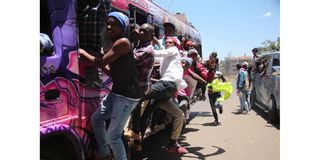
A matatu being driven dangerously along Nairobi's Moi Avenue on September 9, 2018.
So massive was this migration that in a desperate attempt to stem the tide, President Jomo Kenyatta resorted to hurling epithets and threats at anyone even contemplating such a move, to the point of declaring it treasonous in one of his speeches. These harsh words fell on deaf ears and suddenly Nairobi had a big problem.
Battle for supremacy: The underdog wins
The OTC-run Kenya Bus Service was flush with cash and ran with the strict discipline of a school; not surprising, given its British heritage. It was the only legal form of transport allowed in the city: The chimerical Austin, Peugeot, Morris and Bedford microbus potluck gatherings that lurked in the back streets were nothing more than second-tier fringe operations by the Africans for the Africans - just like the Nubian gin (chang'aa) that originated in the Kibera area, where 400 Sudanese ex-soldiers had been settled by the British in recognition of their contribution to victory in one war or another.
But unbeknownst to the haughty OTC folk and the out-of-touch city authorities, the post-independence surge in Nairobi's African population had turned the extralegal transport system from a matter of convenience into a matter of profit. The matatu was born.
Increased profits meant that operators no longer had to drive Frankenstein's monstrosities made from parts scavenged from the corpses of the white man's rejects. They could now afford proper vehicles, and good ones at that.
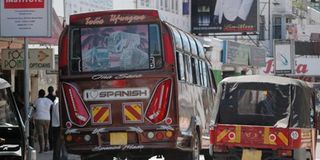
A matatu in Mombasa on April 14, 2014.
Highly rated vans such as the Ford Transit and the Volkswagen Type 2 (aka the Kombi) entered the scene as more and more entrepreneurs threw their hands into this informal and illegal but highly lucrative industry.As the numbers swelled, the previously oblivious OTC and NCC began to take notice, and they were not pleased with what they saw.
For a start, these matatus were very popular, and that's not an exaggeration. We can now call them matatus because the mostly Kikuyu users and operators had a standard fare of magoro matatu (three ten-cent coins), which, not coincidentally, was one of the reasons for their popularity.
The fancy Kenya Bus Service charged 50 cents.But it wasn't just about the fare, it was also about the personalised convenience these taxis offered. Irrespective of systemic constraints and government policy, the matatus were highly flexible.The driver would go where the passengers wanted to go, not where a London-based board of directors decided he should go.
As most of these vehicles carried the same people, at the same times, on the same routes, every day, relationships between passengers and drivers were established and cemented. The flexibility of the matatus meant that if a passenger was late, the driver would wait for him; if he had no fare, he could travel on credit, and the operators were open to barter in lieu of fiat. These relationships were to play a very important role in later developments.
The Kenya Bus/OTC people and their colleagues at the Nairobi City Council could not understand how or why people would prefer a passenger transport system devoid of structure and comfort; why they would rather be packed like sardines in a literal tin can than luxuriate in the spacious accommodation of an ERF bus running on a strict schedule.
Angered by the inexplicable popularity of the second generation vans, their joint reaction was as strange as it was perplexing. The two bodies embarked on a media-driven charm offensive, heavily laced with mutual mastication, in which the Kenya Bus Service blew its own trumpet loud enough to wake up freshly dead colonialists, while the Nairobi City Council sang its praises from the sidelines, equally loud enough to make the resurrected colonialists wish they had never granted this country independence in the first place.
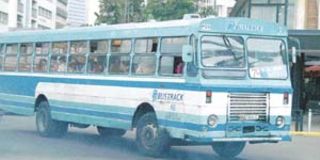
A Kenya Bus Service company vehicle.
One Arthur Kent, director of the Kenya Bus Service, took liberties with statistics and kept a straight face.
One Arthur Kent, director of the Kenya Bus Service, took liberties with statistics and kept a straight face. He explained that in the previous year (1966, if I'm not mistaken) their bus line had carried twenty million passengers (twice the population of Kenya at the time) using a fleet of 112 state-of-the-art vehicles, with more to come.
This was followed by massive investment in pounds sterling to expand the fleet, the establishment of a training school to teach additional subjects not directly related to driving, and the construction of a huge bus park along Nairobi's Temple Road, which we now know as Bus Station - an unimaginative name, but a very apt and straightforward one.
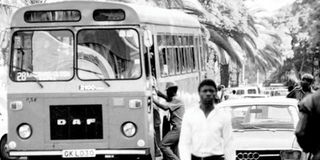
The Nyayo Bus Service was established in 1986 to provide affordable transport to Kenyans and compete with the Kenya Bus Services, a company ran by the City Council of Nairobi. Nyayo was declared insolvent in 1995.
The NCC, on the other hand, practised outright favouritism towards KBS, as if the monopoly transport licence were not enough, while scorning the matatu industry. Tyre suppliers joined the fray, sponsoring advertising campaigns that glamorised the bus service in the media with nauseatingly saccharine slogans that the average African passenger couldn't identify with and cared little about.
Despite all these desperate efforts and more, the one thing that the KBS and the NCC could not deny was that, no matter how hard they tried to force statistics or bend reality, the matatus were a clear and present threat to their continued existence.The matatus, with fewer and smaller vehicles (about 100 matatus compared to KBS's post-expansion 146), were moving more people. The matatus were making more money.
The matatus ate their lunch.
Woop! Woop!That's the sound of the police!
Of course, these matatus were illegal. While it was not illegal to own and drive a van, there were three facets of the matatu business that criminalised operations: firstly, operating without the necessary business licence; secondly, most matatus operated with expired, forged or non-existent road licences; and despite increasing profits and fleet upgrades, a significant number of these vehicles were still unroadworthy remnants of the Frankenstein era.
As they proliferated on Nairobi's streets and estates, attracting the attention of the city council and the corporate stiffs at OTC, they also attracted the attention of a very formidable clique: Babylon. Five-oh. The Feds. The Masans.
The police.
The police swung into action, their efforts intensifying in lockstep with the growth and expansion of the burgeoning matatu industry. Initially, it was the drivers - presumably the owners and most certainly the operators of the vehicles - who were targeted.
The basis of the onslaught was operating without a licence or permit; but for it to be a business, you have to sell a product or service and there has to be a paying customer.
This is where the police discovered the power of relationships and solidarity. As soon as the driver spotted a police car, he would try to evade it by doing vehicle gymnastics, but it didn't always work. Sometimes he was cornered.
When stopped, the driver would simply deny that he was in business and claim that the occupants of the vehicle were not paying passengers, but friends and colleagues who were simply hitchhiking from one place to another.
The passengers, in turn, would corroborate this narrative: "No siree, we didn't pay for this ride, we're just his friends and he's driving us around to show us the city. Are you sure? Sure.
These are the relationships I mentioned earlier.The conspiratorial collusion that resulted from the symbiotic relationship between driver and passenger made apprehension a particularly tricky affair, with a near-zero success rate.
Passengers didn't want to see the driver arrested, fined or put out of business for improving their lives, but more importantly, they were really friends, it wasn't a lie. The lack of success with this method led the police commissioner, one S. K. Raval, to widen his dragnet in 1967 by adjusting the definition of a matatu to close loopholes.
A matatu was no longer just a vehicle with paying passengers (plausible deniability), the definition became "a private vehicle which regularly carries passengers near a bus stop or along the same route more than three times a day is a pirate taxi", and once this criterion was met and the operator caught, the law worked in reverse: it was the driver's responsibility to convince the court that he was not running a matatu business. Guilty until proven innocent.
Of course, this law was unfair and indicative of the increasing desperation of the police, but each time the passengers intervened, claiming they were friends of the driver and not customers, so... no. Not a business, not a pirate, not a taxi. This was going nowhere fast.Time for take two.
The drivers were proving slippery - and with the support of their passengers, impossible to catch; so the police changed tactics and decided to target the vehicles and their roadworthiness (or lack thereof). In scenes that would be very familiar today, the boys in blue set up surprise roadblocks and inspections that targeted these vehicles, whether they had a licence or not, and their physical condition.
As is typical of public service vehicles, few, if any, would pass the inspections, and this gave rise to another age-old tradition that lives on to this day: the exchange of the folded note.
Coincidentally, the operators discovered that bribing the police was an acceptable cost of doing business at the same time as the police realised that this new source of income was a worthy addition to their meagre salaries, and thus began a long, tumultuous and torrid love affair between these two entities.
What had once been a Tom and Jerry running battle with no winners was now a new symbiosis in which everyone was a winner. It became a new relationship whose dynamics have never changed since.
Like a wealthy, overpowered film villain who is repeatedly thwarted by the brave and cunning underdog, S K Raval refused to give up. He made one last attempt, this time overlooking the drivers and their vehicles and instead targeting the passengers for aiding and abetting an illegal enterprise. This didn't work either, as the evasion tactics were no different from before.
Passengers simply denied paying any fares, thus absolving themselves of any culpability, and after a few years it became clear that the matatu was here to stay, whether they liked it or not.
In 1973, the no longer fledgling industry finally received formal recognition from the highest authority in the land: the President himself, Jomo Kenyatta.
Tune in to the next part of this historical analysis as we trace the roots of Kenya's matatu industry, discuss its bleak present and how it can navigate its way into a relevant future. Much of the credit goes to Kenda Mutongi and his book: Matatu: A History of Popular Transportation In Nairobi, for providing invaluable insights and priceless historical nuggets on the origins and evolution of the industry since pre-independence.





